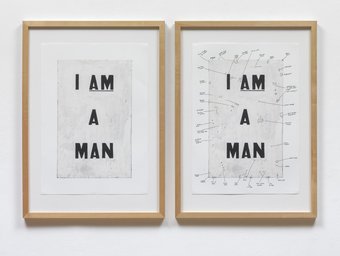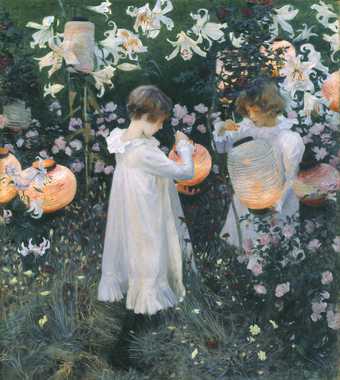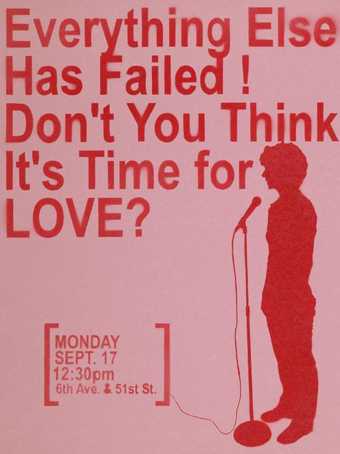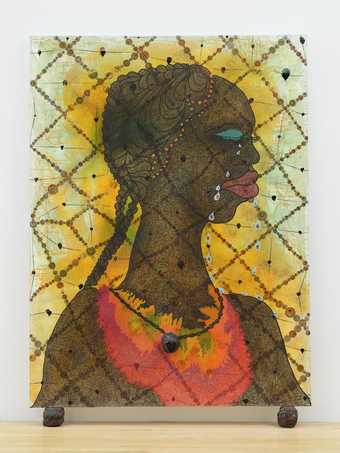Condition Report is comprised of two framed images printed on paper.
Behind the glazing of each frame the sheets of paper measure 81 centimetres high by 58 centimetres wide.
On each panel there is a short statement shown in large black text, it reads: I AM A MAN
On both panels the statement reads from top to bottom in three equally spaced out rows the words.
'I AM' appear on the top row. The letter 'A' makes up the second row and the word 'MAN' takes up the third row.
The text is shown in uppercase letters and presented in a plain font against a greyish white background.
Bold and clear, the words have a further impact by being shown twice:
I AM A MAN
I AM A MAN
In both sets of text the word 'AM' is underlined with a rather thin straight line in comparison to the more thick set lettering.
Given the slight emphasis on one word the statement could read:
I 'AM' A MAN
The two frames are shown in portrait format and they hang together side by side forming a pair.
Each printed image is positioned centrally and each roughly measures 62 centimetres high by 39 centimetres wide, moderately smaller than their sheets of paper.
These printed images have margins with straight lines surrounded by areas of white paper. In the frame on the right however the dimensions of the printed image are confused by additional features around its margins. Here there is an assortment of small notations and marks that appear to be handwritten in black pen.
The two framed images are identical except that one is marked with lines, squiggles and small handwritten words.
Despite these tiny markings the large letters of the main text remain clear, still boldly declaring the message:
I AM A MAN
With this repeated statement the two panels resemble signs or placards that declare identical slogans.
Another placard-like feature is the artwork's handmade quality. Although all the letters have straight lines and no curves they appear to be painted by hand.
That greyish white background looks even more roughly painted with rushed uneven brushstrokes.
Both images are printed reproductions of one handmade painting.
The print on the right though with its overlaid notations is a reproduction of marks made by handwriting as well as by hand painting.
Condition Report was made in 2000 by the American artist Glenn Ligon. Here Ligon has twice reproduced his own painting in separate prints. The original painting completed 12 years earlier in 1988 is called Untitled (I AM A MAN)
The painting is based on signs carried by Black sanitation workers marching for civil rights in 1968 in Memphis Tennessee. The workers were on strike campaigning for better wages and better treatment.
Martin Luther King on the day of his assassination had gone to Memphis in support of the sanitation workers' march.
20 years later, Ligon made his painted version of the sign on canvas using a combination of fine art oil paint and sign painting enamel, two materials that dry at different rates.
Over time small cracks appeared across the painting surface and some areas became discoloured.
To produce Condition Report Ligon had the condition of his own painting examined by painting conservator Michael Duffy. Duffy added small notations in black pen over the top of a printed reproduction of Ligon's painting.
This is all now on show on the right panel of Condition Report. With dots and squiggles Duffy highlighted various surface blemishes and he penned a series of thin lines that point at the highlighted areas
These pointing and lines trail in from tiny handwritten words outside the margins. Words that specifically identify those blemishes, words like 'smudge', 'hairline cracks' and 'dark scrape'.
For Ligon the theme of change went further. Just as the painting could change so could the interpretation of its words. Ligon's perspective on Black American history was that of a contemporary Black American born in 1960 and making this artwork in 2000. In portrait format the artwork has been read as a form of self-portraiture. The words I AM A MAN could be Ligon's personal plea for equal treatment both in American society and in the American art world.
Additionally in his art and in his life as a gay man, Ligon was already questioning traditional notions of manliness. His interest in civil rights history increasingly focused on activists like James Baldwin who not only experienced racism but also homophobia from all sides.
Ligon concluded that images and words when seen in different circumstances over time can be reinterpreted.
Condition Report asserts that artworks and history are far from static or fixed. They are as years go by subject to changing conditions.
This audio description was written and recorded by John Hughes.




